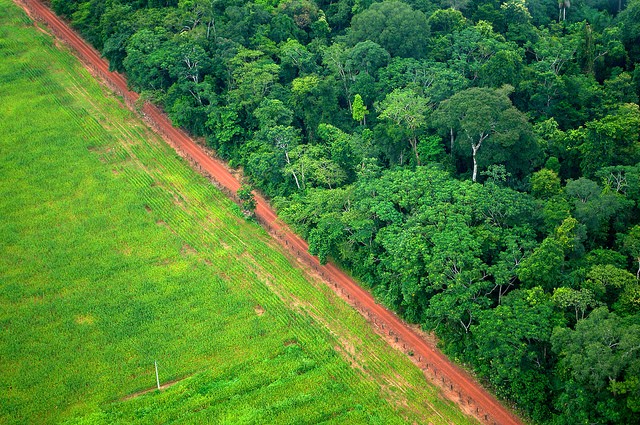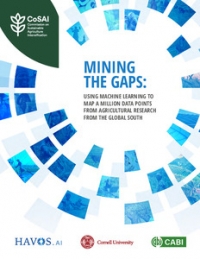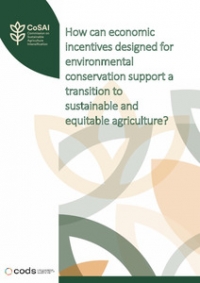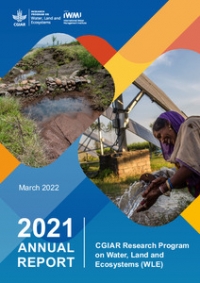One would wish to have a direct and simple answer to this big question: Yes we can! But unfortunately there are no free lunches, and whatever strategy we will adopt to satisfy global food demand, food production will inevitably have adverse impacts on our environment.
 Between 1990 and 2010 Latin America has lost over 1 million of km2 of tropical forest, becoming the second largest deforestation hotspot in the world, only preceded by Southeast Asia. Photo: CIFOR
Between 1990 and 2010 Latin America has lost over 1 million of km2 of tropical forest, becoming the second largest deforestation hotspot in the world, only preceded by Southeast Asia. Photo: CIFORIn some regions people will suffer from water scarcity or water bodies will be polluted from overuse of chemical fertilizers. In other regions increasing food production will have negative consequences for biodiversity and the provision of many other ecosystem services that we rely on.
So maybe we should be a bit less ambitious. We could, for example, ask ourselves what options we do have for feeding the world in the years to come at the lowest environmental cost. Fortunately, it is possible to provide some insights into this question.
Researchers from the Technical University of Madrid, the International Food Policy Research Institute (IFPRI) and Harvard University have just published a paper in PLOS ONE which jointly assesses issues of future global food security and environmental outcomes. The study describes different future agricultural production pathways in one of the most important food baskets of the world: Latin America.
Latin America is the region with the greatest agricultural land and water availability per capita in the world. It holds 15% of the global agricultural land and 33% of available, renewable water resources. This environmental resource richness has fueled rapid export growth of primary goods. In just 30 years, the Latin American agricultural market share has almost doubled from 10% in 1980 to 18% in 2010.
On the one hand, such exponential growth has fueled agricultural and economic development in the region, and gave Latin America a pivotal role in meeting global food demand. On the other hand, food exports have also brought about important adverse environmental impacts. Between 1990 and 2010 Latin America has lost over 1 million of km2 of tropical forest, becoming the second largest deforestation hotspot in the world, only preceded by Southeast Asia. This deforestation might contribute to a gradual drying up of southern Brazil and northern Argentina.
If we want to maintain a livable planet for our grandchildren, we cannot continue down this path. Population growth and rising living standards accompanied by dietary shifts throughout the world are increasing the demand for food. The growing desire to consume animal products, but also oils, sugars and vegetables rather than sorghum or millet, for example, is particularly resource-use intensive. It is therefore important that Latin America continues to contribute to feeding the world in the future, but that it does so in a more sustainable way than in the past.
The PLOS ONE article addresses the contribution of Latin America’s food exports to meet future food demand up to 2050 and discusses trade-offs with water consumption, water quality, biodiversity and carbon stock losses in the region.
The issues are assessed looking at various future agricultural production scenarios for Latin America, including a business-as-usual scenario (BAU), agricultural intensification, sustainable intensification, agricultural extensification and further, global removal of price and marketing distortions.
Expansion or intensification?
The alternative scenario of increased extensification in the Latin America region achieves increased food production through low-input agriculture combined with increased agricultural land expansion.
This production pathway can reduce water consumption and pollution levels in some Latin American countries and areas within countries, but leads to very high rates of land conversion, especially in Argentina and Brazil with adverse impacts on carbon stock and biodiversity levels. Moreover, extensification contributes little to Latin American and global food security.
Contrarily, the scenario of agricultural intensification reduces land use change, but places pressure on water-scarce regions, like the state of Tocantins in Brazil and coastal Peru. Also, more conventional intensification entails higher risks of water pollution, particularly for northeastern Brazil and parts of Mexico. On the food security side, important reductions in global food prices and thus in the number of undernourished children can be achieved under intensification.
Sustainable intensification: a reality?
The most favorable scenario is the sustainable intensification scenario, which achieves the same productivity and food security impacts as the intensification scenario but also uses natural resources more efficiently.
For the sustainable intensification scenario to become a reality in Latin America, higher investments in research and development in agriculture and better management of natural resources will be needed.
Examples include breeding for more nutrient-efficient crop varieties, targeted further expansion of no-till agriculture, and more rapid development of affordable precision agricultural tools adapted to the region, as well as improved monitoring and enforcement of regulations concerning water pollution. Furthermore, sub-surface drip irrigation technologies, coupled with modernized irrigation systems, have the potential to significantly increase water productivity.
A competitive advantage
Intensifying agriculture in Latin America is crucial for improved food security globally and can be done with reduced adverse environmental impacts for the region. However, we also find that further removal of price and marketing distortions is critical for global food security and environmental outcomes.
Removing price and market distortions reduces prices for several key food commodities and strengthens production in those countries and regions that have the greatest comparative advantage.
For Latin America, which is gifted with relative natural resource abundance, this would, however, not only mean increased production of livestock and soybeans but also increased pressure on natural resource use, such as water and land and thus greater threats to biodiversity levels.
Thus, while we cannot meet future global food demands without causing further environmental damage, we can substantially reduce the level of damage through enhanced policies, investments and institutions, such as through more optimized fertilizer use and enhanced water management.
Specific technologies suitable to the Latin America region include investments in precision agriculture and nutrient use efficiency; and enforcement of water quality regulations and enhanced river basin management.
Contrasting land expansion against more intensified agriculture suggests that productivity improvements are generally superior to agricultural land expansion, from a food security and environmental point of view.
Removing price and trade distortions is important for global food and environmental security; it will increase Latin America’s contribution to future food production but will also worsen its environmental pressures.
This further shifts the onus on the need for increased sustainability of production in the region.























Comments
I've been thinking about artificial meat. They've said that all farmers (Canada) should be given the ability to blend their meat with fake meat. They claim all that is needed is feed and a type of bacteria.
In retrospect, Swine Flu and SARS have better prepared the world, but it is claimed by getting rid of real meat, we will be better able to focus on the vectors that might cause a type of bioevent that wipes out the biosphere (this century). I think they want us to build zoos for migrating birds and wipe them out eventually. Or perhaps gene therapy their immune systems.
So, meat farmers will grow feed and have little bioreactors or whatever equipment and I assume the meat will fry properly.
Pines aren't edible like I thought. Ants are too acidic. But we could engineer those honey ants and a sugar producing plant, for civil defence purposes. It would alter the ecosystem.